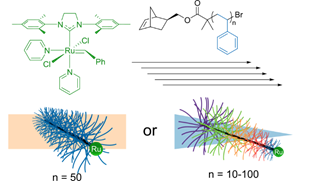Reports: DNI754884-DNI7: Tapered Bottlebrush Polymers: A New Polymer Topology
John B. Matson, PhD, Virginia Polytechnic Institute and State University
Bottlebrush polymers are unique macromolecules comprised of polymeric side-chains densely grafted to a polymer backbone. The highly branched nature of bottlebrush polymers leads to steric repulsion between polymeric side chains, forcing these macromolecules to adopt a chain-extended conformation. As a result, bottlebrush polymers have unique mechanical properties and may find applications in areas including rheology modifiers, super-soft elastomers, and photonic crystals, among others. Our long-term goals are to explore new synthetic methods to make bottlebrush polymers and apply them to synthesize cone-shaped versions of the polymers. This report focuses on our synthetic efforts, detailing our work on two synthetic efforts related to this project: 1) Developing new chain transfer agents (CTAs) for use in reversible addition–fragmentation chain transfer (RAFT) polymerization to make macromonomers; and 2) Preparing tapered (cone-shaped) bottlebrush polymers using sequential addition of macromonomers ring-opening metathesis polymerization (SAM-ROMP).
In the first project, we investigated the effect of various experimental conditions in RAFT transfer-to synthesis of bottlebrush polymers. RAFT transfer-to is similar to grafting-from but requires that the chain transfer agent (CTA) be linked to the bottlebrush polymer backbone through its Z-group. This work was led primarily by three graduate students (Scott Radzinski and Jeffrey Foster) but most of the experiments were carried out by undergraduates (Sally Lewis and Eric French). Here we found that the lowest quantities of dead polymer were formed under conditions that limited the molecular weight of the bottlebrush polymer side chains and that limited radical-radical termination reactions. Under these optimized conditions, high molecular weight bottlebrush polymers with narrow dispersities and low dead chain fractions were formed (Figure 1).
|
|
Figure 1. SEC traces over time in the transfer-to synthesis of bottlebrush polymer of methyl acrylate (A) and acryloyl morpholine (B).
|
In the second project, tapered (cone-shaped) bottlebrush polymers were synthesized through the sequential ROMP of five polystyrene macromonomers of various molecular weights (1 kg/mol to 10 kg/mol; Figure 2). This allowed us to bottlebrush polymers with shape asymmetry. The key to a successful polymerization over successive additions of macromonomer was to mitigate catalyst death by making the ROMP reaction as fast as possible. This require the use of extremely pure macromonomer, the ideal ROMP anchor group, as we noted in our first report, and conditions that are favorable for ROMP (100 mg/mL monomer in EtOAc). This work was led by Jeffrey Foster, Scott Radzinksi, Kyle Arrington, and Jeffrey Weaver (all graduate students) but had contributions from an undergraduate (Samantha Scannelli).
|
|
Figure 2. Synthesis of symmetric and asymmetric bottlebrush polymers using a sequential-addition of macromonomers (SAM) strategy.
|
The impact of this award on graduate and undergraduate students at Virginia Tech has been substantial. Two graduate students (Scott Radzinski and Kyle Arrington) have been funded in part on this grant in the past year. In addition, seven undergraduates (Sally Lewis, Matt Slutzker, Samantha Scanneli, Karen Tran, Kyle Moran, Eric French, and Kearsley Dillon) have contributed to this project since its inception. As noted above, for the first project the undergraduate students carried out many of the experiments under supervision from the graduate students. Two undergraduates (Lewis and French) contributed as co-authors on a paper this year, while others contributed to other papers.
This grant has also impacted my career. Thus far five papers have been published with support from this award. I presented results from this work at an invited talk at the 254th American Chemical Society National Meeting in Washington, DC in August 2017 and at the 46th World Chemistry Congress in Sao Paulo, Brazil in July 2017. I have also been invited to speak at several departmental seminars across the country, at which I have referenced this work and this award.













